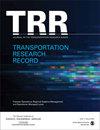电动两轮车横向变速与驾驶风格预测模型
IF 1.8
4区 工程技术
Q3 ENGINEERING, CIVIL
引用次数: 0
摘要
紧凑的尺寸,缺乏可用的物理保护,以及机动两轮车(MTW)车手复杂的操作模式使他们更容易发生碰撞风险和事故。考虑到密集城市混合交通环境下MTWs的脆弱性增加,对其横向移动决策和驾驶方式进行适当的评估和建模可以提高与乘客相关的安全性,并提高现有微观仿真模型的可靠性。本研究利用一条六车道城市主干道的轨迹数据,试图调查MTWs的横向移动趋势,解决可能影响乘客决策的不同影响变量,并描述这种选择如何受到当前交通状况的影响。基于车速变化、角度位置变化、与后车保持的纵向间隙等驾驶风格参数,本研究进一步完善了已有文献,提出了一种识别横向换档过程中驾驶员驾驶风格的新指标。多项logit模型的建模结果表明,在模拟驾驶员的横向换挡决策时,考虑纵向和横向间隙、车速以及受试者MTW在过去轨迹中产生的横向波动的重要性。将横向波动次数作为MTWs驾驶风格的一个指标,定义了一个新的“攻击性指数”,并据此提出了一种对驾驶员的攻击性和非攻击性驾驶风格进行分类的建模方法。研究结果表明,横向换挡时,应考虑受试者过去的轨迹历史,考虑参数之间的非线性关系,可以更好地对MTW车手的驾驶风格进行分类。本文章由计算机程序翻译,如有差异,请以英文原文为准。
Model for Predicting Lateral Shifts and Driving Style of Motorized Two-Wheelers
The compact sizes, lack of available physical protection, and complex maneuvering patterns of motorized two-wheeler (MTW) riders make them more vulnerable to crash risks and accidents. Considering the increased vulnerability of MTWs in dense urban mixed traffic environments, a proper evaluation and modeling of their lateral movement decisions and driving style can enhance safety associated with the riders and augment the reliability of the existing microsimulation models. Utilizing trajectory data of a six-lane divided urban arterial, the current study attempts to investigate the lateral movement (lateral shift) tendency of MTWs, addressing different influential variables that may affect riders’ decisions and describing how this choice is affected by prevailing traffic conditions. Based on several driving style parameters, such as change in speed, change in angular position, and longitudinal gap maintained with rear vehicles, this study further contributes to the existing literature by proposing a new index for identifying the driving style of riders during the lateral shifting process. Modeling results of a multinomial logit model indicated the importance of considering longitudinal and lateral gaps, vehicle speeds, and lateral fluctuations made by the subject MTW in the past trajectories in modeling the lateral shift decisions of riders. Considering the number of lateral fluctuations as an indicator of MTWs’ driving style, a new “aggressiveness index” is defined and, accordingly, a modeling approach is proposed to classify aggressive and non-aggressive driving styles of the riders. The results suggest that the history of past trajectories of the subject MTW during lateral shifting should be considered, and consideration of a non-linear relationship among the parameters can result in a better classification of driving style of MTW riders.
求助全文
通过发布文献求助,成功后即可免费获取论文全文。
去求助
来源期刊

Transportation Research Record
工程技术-工程:土木
CiteScore
3.20
自引率
11.80%
发文量
918
审稿时长
4.2 months
期刊介绍:
Transportation Research Record: Journal of the Transportation Research Board is one of the most cited and prolific transportation journals in the world, offering unparalleled depth and breadth in the coverage of transportation-related topics. The TRR publishes approximately 70 issues annually of outstanding, peer-reviewed papers presenting research findings in policy, planning, administration, economics and financing, operations, construction, design, maintenance, safety, and more, for all modes of transportation. This site provides electronic access to a full compilation of papers since the 1996 series.
 求助内容:
求助内容: 应助结果提醒方式:
应助结果提醒方式:


